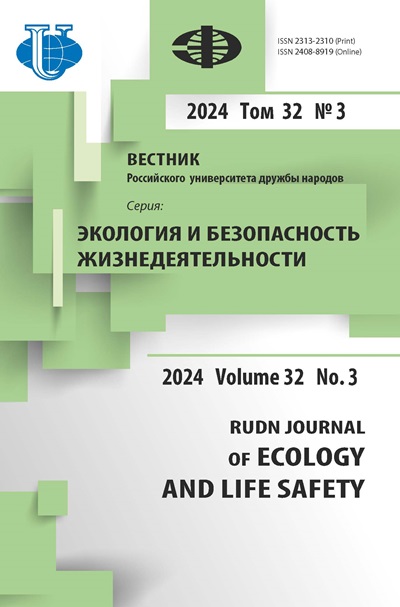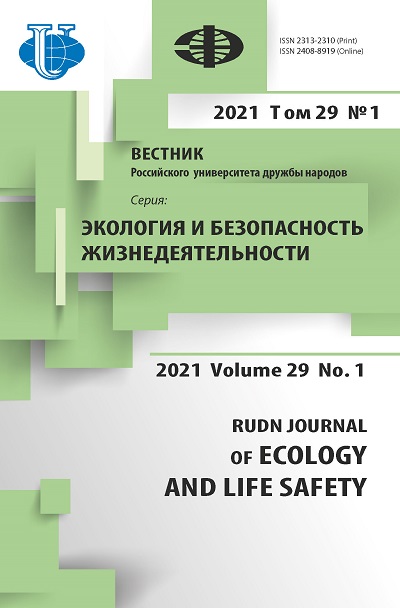Minimization of the impact of rubble production wastes on the environment by their involvement in the compositions of road'building materials
- Authors: Konovalova N.A.1, Pankov P.P.1, Bespolitov D.V.1
-
Affiliations:
- Trans-Baikal Institute of Railway Transport
- Issue: Vol 29, No 1 (2021)
- Pages: 82-91
- Section: Environmetal defence
- URL: https://journals.rudn.ru/ecology/article/view/29488
- DOI: https://doi.org/10.22363/2313-2310-2021-29-1-82-91
Cite item
Full Text
Abstract
The impact of Taldan crushed stone plant and wastes formed in process of its activity on the environment is considered. About 2.9 million tons of siftings of rock grinding were accumulated in dump massifs with a total area of 600 hectares. Therefore, elimination of accumulated harm to the environment that has arisen over many years of operation of Taldan crushed stone plant is the actual task. One of the technological solutions of liquidation of objects of accumulated harm to the environment based on physicochemical impact on wastes is stabilization or artificial stone formation. Drawing of siftings of rock in soil concrete compositions (artificial stone materials) allows to solve complex of acute environmental problems due to their largetonnage direct use. The use of siftings of rock in road building will contribute to the rational and cost-effective use of natural mineral raw materials, since this process will not entail an increase in the costs of its extraction and processing. A set of modern methods (atomic-emission spectrometry with inductively coupled plasma, scanning electron microscopy, X-ray phase analysis, infrared spectroscopy) were used to study the chemical, phase composition and properties of siftings of rock to substantiate the possibility of its utilization in the composition of soil concrete. It is shown that the introduction of an 8 wt. % of mineral binder and polymer stabilizing additive “Element” (1, 5, 10 wt. %) allows to get soil concrete with a mark of strength М100.
About the authors
Nataliya A. Konovalova
Trans-Baikal Institute of Railway Transport
Author for correspondence.
Email: zabizht_engineering@mail.ru
PhD in Chemistry, leading researcher
11 Magistralnaya St, Chita, 672040, Russian FederationPavel P. Pankov
Trans-Baikal Institute of Railway Transport
Email: pavelpankov110990@mail.ru
junior researcher
11 Magistralnaya St, Chita, 672040, Russian FederationDmitry V. Bespolitov
Trans-Baikal Institute of Railway Transport
Email: zabizht_engineering@mail.ru
graduate student
11 Magistralnaya St, Chita, 672040, Russian FederationReferences
- Khudyakova LI, Voyloshnikov OV, Kislov EV. The ways of rational nature using increasing on example of North Baikal ore region. Journal of Siberian Federal University. Engineering & Technologies. 2011;4(2):155–161. (In Russ.)
- Matinde E, Simate GS, Ndlovu S. Mining and metallurgical wastes: a review of recycling and re-use practices. Journal of the Southern African Institute of Mining and Metallurgy. 2018;118(8):825–844.
- Kasemodel MC, Sakamoto IK, Varesche MBA, Rodrigues VGS. Potentially toxic metal contamination and microbial community analysis in an abandoned Pb and Zn mining waste deposit. Science of the Total Environment. 2019;675:367–379.
- Razmahnin KK, Blinovskaya YaYu. Geo-ecological aspects of natural-technical system functioning in processing of zeolite-bearing rocks. Interekspo GEO-Sibir'. 2018;5: 183–187. (In Russ.)
- Brooks SJ, Escudero-Onate C, Lillicrap AD. An ecotoxicological assessment of mine tailings from three Norwegian mines. Chemosphere. 2019;233:818–827.
- Krechetov P, Chernitsova O, Sharapova A, Terskaya E. Technogenic geochemical evolution of chernozems in the sulfur coal mining areas. Journal of Soils and Sediments. 2019;19:3139–3154.
- Shi P, Zhang Y, Hu Z, Ma K, Wang H, Chai T. The response of soil bacterial communities to mining subsidence in the west China Aeolian sand area. Applied Soil Ecology. 2017;121:1–10.
- García-Lorenzo ML, Marimón J, Navarro-Hervás MC, Pérez-Sirvent C, MartínezSánchez MJ, Molina-Ruiz J. Impact of acid mine drainages on surficial wasters of an abandoned mining site. Environmental Science and Pollution Research. 2016;23:6014–6023.
- Bugaeva GG, Kogut AV. Еnvironmental risk factors in the area of open mining. Gornyj Informacionno-Analiticheskij Byulleten'. 2007;9(12):292–296. (In Russ.)
- Khafizova EN, Akhtyamov VF. Concrete production based on industrial non-metallic wastes. Vestnik of Tomsk State University of Architecture and Building. 2017;(4): 107–116. (In Russ.)
- Puharenko YuV, Panarin SN, Veselova SI, Cherevko SA. Use of waste stone crushing in concrete. Tekhnologii Betonov. 2013;11(88):34–35. (In Russ.)
- Dalatkazin AA. Crushing screenings: a problem to be solved. Stroitel'nye Materialy. 2006;(8):28–29. (In Russ.)
- Kovalenko DS. Prospects of using the technogenic raw material of Lugansk people’s republic in the building industry. Vestnik Donbasskoj Nacional'noj Akademii Stroitel'stva i Arhitektury. 2017;124(2):71–74. (In Russ.)
- Krasheninnikov ON, Belogurova TP, Lashchuk VV, Pak AA. Overburden rocks of the Kola Peninsula deposit and production of crushed stone on their basis. Ekologiya Promyshlennogo Proizvodstva. 2007;(1):64–73. (In Russ.)
- Genkel AV, Grishin IA, Burmistrov KV, Velikanov VS. Obtaining the efficiency of crushed stone production and methods of using crushing screenings. Gornaya Promyshlennost'. 2015;124(6):64–68. (In Russ.)
- Zhernovskij IV, Osadchaya MS, Cherevatova AV, Strokova VV. Aluminium-silicate nano-structured on the basis of granite raw material. Stroitel'nye Materialy. 2014;(1–2): 38–41. (In Russ.)
- Zengxiang L, Meifeng C. Disposal methods in solid wastes from mines in transition from open-pit to underground mining. Procedia Environmental Sciences. 2012;16:715–721.
- Zhou L. Investigation and practice on mining land rehabilitation and ecological reconstruction in China. Nonferrous Metals. 2007;2(59):90–94.
- Artamonov VA, Vorobev VV, Svitov VS. Experience in processing crushing screenings. Stroitel'nye Materialy. 2003;(6):28–29.
- Pugin KG, Pugina VK. Features of use of the resource potential of waste products for building constructions and materials. Fundamental'nye Issledovaniya. 2016;(9):289–293.
















